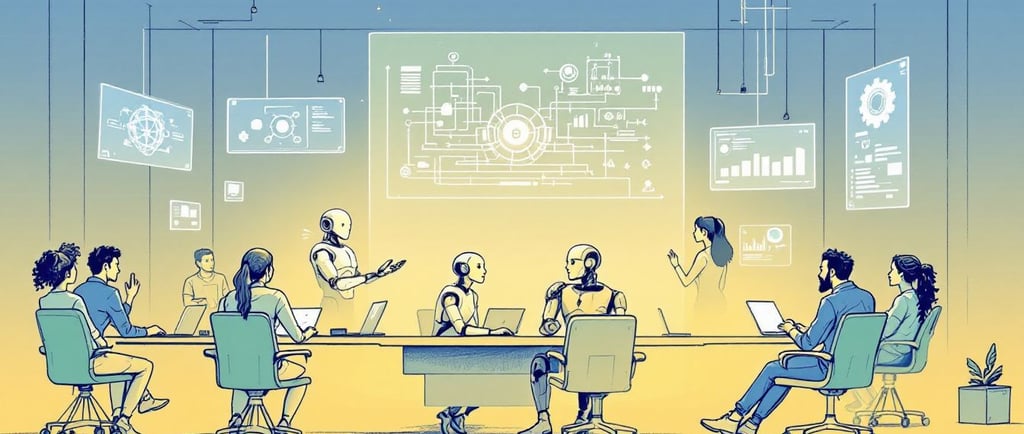The Future of Work: Agentic AI and Human Collaboration
How AI-Powered Autonomous Agents Are Redefining Workforce Dynamics
Arpit Singh
1/26/20252 min read


How AI-Powered Autonomous Agents Are Redefining Workforce Dynamics
The rise of Agentic AI is revolutionizing the workplace, reshaping how businesses operate and how humans collaborate with technology. Unlike traditional automation, which focuses on replacing repetitive tasks, Agentic AI goes a step further—acting as an independent decision-maker, optimizing workflows, and even enhancing human capabilities.
As AI agents become more intelligent, adaptive, and proactive, they are no longer just tools but collaborators that amplify human potential. But what does this mean for the future of work? Will AI replace human jobs, or will it enable employees to focus on higher-value, strategic tasks?
How Agentic AI is Reshaping the Workplace
✅ Augmenting Human Intelligence, Not Replacing It
The biggest misconception about AI is that it is here to replace human jobs. However, studies show that AI augments human capabilities, making employees more productive rather than eliminating roles altogether.
🔹 Example: Salesforce’s Einstein AI enhances sales and marketing teams by providing real-time customer insights, automating data analysis, and predicting deal closures.
🔹 Impact: Employees can focus on client relationships and strategy while AI handles data-heavy tasks.
✅ AI-Powered Decision-Making & Automation
Agentic AI is capable of analyzing vast amounts of data and making independent decisions, reducing human intervention in routine decision-making processes.
🔹 Example: IBM Watson assists financial analysts by analyzing financial reports, market conditions, and risk factors, enabling faster, more informed investment decisions.
🔹 Impact: More accurate decision-making, reduced human error, and faster insights.
✅ The Emergence of AI-Powered Workflows
AI-powered virtual assistants and intelligent workflow automation are helping employees manage emails, schedule meetings, and streamline documentation without manual intervention.
🔹 Example: Microsoft Copilot assists knowledge workers by automating report generation, summarizing meetings, and drafting emails.
🔹 Impact: Time savings, increased productivity, and reduced administrative burden.
Industries Leading AI-Driven Workforce Transformation
🏥 Healthcare & Life Sciences
AI is enhancing the efficiency of doctors and healthcare professionals by automating patient records, diagnostics, and treatment recommendations.
🔹 Example: Mayo Clinic’s AI-powered diagnostics use AI models to predict disease outcomes and assist in medical imaging analysis.
📊 Finance & Investment Management
Investment firms and banks are deploying AI to automate risk analysis, fraud detection, and customer interactions.
🔹 Example: JPMorgan’s AI-powered trading system helps traders analyze market movements in real time, reducing decision-making lag.
🔬 Scientific Research & Development
AI agents are helping scientists automate research processes, analyze large datasets, and even assist in drug discovery.
🔹 Example: DeepMind’s AlphaFold accelerates protein structure prediction, revolutionizing biotech research.
Challenges in Human-AI Collaboration
While AI offers tremendous benefits, businesses must address key challenges to ensure seamless human-AI collaboration:
Workforce Training: Employees need AI literacy training to work effectively with intelligent systems.
Job Redefinition: Companies must redesign job roles to leverage AI-assisted decision-making.
AI Trust & Ethics: Businesses must ensure AI decision-making is transparent, unbiased, and ethically aligned.
The Future of AI-Augmented Workforces
A report by McKinsey predicts that by 2027, AI will automate 50% of routine tasks in the workplace, freeing up employees for higher-value work.
The next evolution of workplace AI will include:
🔹 AI-driven leadership support – AI agents advising executives on strategy and operations.
🔹 Hyper-personalized AI assistants – AI tools tailored to individual employees’ preferences and productivity styles.
🔹 AI-driven workforce planning – AI analyzing workforce data to predict talent shortages and recommend hiring strategies.
Final Thoughts: Why Businesses Must Adapt to AI Collaboration
Agentic AI is not a threat to jobs—it’s an opportunity to elevate human potential. Businesses that integrate AI-powered workflows will create more agile, efficient, and innovative teams.
Organizations that embrace AI-human collaboration will be the industry leaders of the future, transforming work into a more strategic, high-value experience rather than a repetitive, task-driven process.
🔗 Further Reading: AI and the Future of Work
Get in touch
Address
RG Trade Tower
Netaji Subhash Place, Pitampura, Delhi, 110034
Contacts
+91 97110 93598
info@quantackle.com
